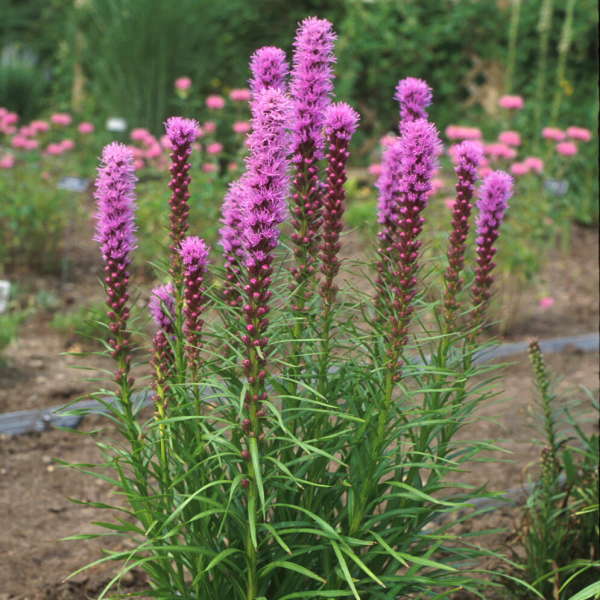
Liatris spicata
Common name: Dense Blazing Star
Blazing Star Beauty: A Comprehensive Guide to Growing Liatris Spicata
Liatris spicata, known as Blazing Star or Gayfeather, is a perennial wildflower admired for its tall, striking spikes of purple flowers. It's a favorite in gardens for its vertical accent and ability to attract pollinators.
Features dense spikes of feathery, bright purple flowers in mid to late summer.
Ideal for adding height and drama to perennial borders and wildflower gardens.
Attracts butterflies, bees, and other beneficial insects.
Plant Care
Proper care is essential for the healthy growth and flowering of Blazing Star.
Sunlight: Full sun is preferred for the best flowering results, essential for vibrant and healthy blooms.
Soil: It prospers in well-drained soil but also shows a good tolerance for poor soil conditions, making it adaptable.
Watering: This plant becomes drought-tolerant once established, although regular watering is needed in the early stages.
Spacing: Plant them about 12-15 inches apart to ensure sufficient space for proper growth and development.
Planting and Propagation
Planting and propagating Liatris spicata can add elegance and beauty to your garden.
Plant corms in spring or fall, about 1-2 inches deep.
Propagate by dividing clumps in early spring or by seeds.
Seedlings may take a few years to flower.
Pests and Diseases
Liatris spicata is relatively pest-resistant and hardy, but it's good to be vigilant.
Keep an eye out for aphids and treat with insecticidal soap if necessary.
Rarely troubled by serious diseases; root rot can occur in overly wet conditions.
Proper spacing and well-drained soil help prevent most problems.
Feeding and Fertilizing
Initial Feeding: Apply a balanced, slow-release fertilizer in early spring as new growth begins. A 10-10-10 NPK ratio is ideal for providing essential nutrients to support initial growth and robust flowering.
Soil Preparation: Before planting, enrich the soil with organic compost to improve fertility and drainage. Liatris spicata thrives in well-drained soils and does not do well in wet, soggy conditions.
Supplemental Feeding: If grown in less fertile soils, consider a mid-season application of a balanced, water-soluble fertilizer to enhance blooming and vigor.
Avoid Over-Fertilization: Excessive fertilizer, especially high in nitrogen, can lead to lush foliage at the expense of blooms. It is crucial to maintain a balance to promote optimal flowering.
pH Preference: Prefers slightly acidic to neutral soil (pH 6.0-7.0). Adjusting the soil pH can improve nutrient uptake and enhance plant health and flowering.
Consistent Feeding: Regular, appropriate fertilization during the growing season supports the plant’s vertical growth and vibrant, purple flower spikes, ensuring a spectacular display in the garden.
Seasonal Care
Seasonal adjustments are important for the year-round care of your Blazing Star.
Deadhead spent flowers to maintain a neat appearance.
Leave the foliage in place over winter to provide garden interest and protect the corms.
Cut back in early spring before new growth begins.
Plant Uses
Blazing Star is versatile and can be used in various garden designs and settings.
Perfect for adding vertical interest in borders, meadows, and naturalistic gardens.
The flowers are excellent for cutting and add drama to bouquets.
Plant in groups for a bold, eye-catching display.
Varieties and Cultivars
Liatris spicata, commonly known as blazing star or gayfeather, is a striking perennial native to eastern North America. Renowned for its tall, dense spikes of purple flowers, it adds a bold vertical element to gardens and attracts a host of pollinators, including butterflies and bees. Liatris spicata thrives in a variety of garden settings, making it a versatile choice for many gardeners.
Liatris spicata
Appearance: This plant typically grows 2 to 4 feet tall, with grass-like foliage and a stiff, upright growth habit. The flower spikes are densely packed with vibrant purple flowers that bloom from the top down, a unique characteristic among flowering plants.
Blooming Period: Flowers in mid-summer to early fall, providing color and interest when many other perennials are starting to fade.
Habitat Preferences: Prefers full sun and well-drained soil. It is drought-tolerant once established, making it suitable for xeriscaping and low-water gardens.
Ecological Benefits: Highly attractive to butterflies, especially monarchs, and other pollinators. It is also used by native bees as a nectar source.
Uses in Landscaping: Ideal for perennial borders, wildflower meadows, pollinator gardens, and cut flower gardens. Its tall and striking flower spikes make it a great choice for the middle or back of garden beds.
Several notable cultivars of Liatris spicata enhance certain characteristics such as flower color and plant size:
'Kobold': A popular dwarf cultivar that reaches about 18 to 24 inches in height, making it more suitable for smaller gardens or the front of borders. It still features the vibrant purple flowers typical of the species.
'Floristan White': This cultivar offers a different look with its white flower spikes, providing a nice contrast when planted among the more common purple varieties.
'Floristan Violet': Similar to 'Floristan White', this cultivar has dense spikes of deep violet flowers and is known for its robustness and long-lasting blooms.
'Alba': Another white-flowered variety, 'Alba' shares the same growth habits and preferences as the species but adds variety with its light-colored blooms.
Liatris spicata and its cultivars are relatively easy to care for, requiring little maintenance beyond occasional watering and dividing every few years to maintain vigor. These plants are effective not only for their aesthetic appeal but also for their ability to support wildlife, making them a valuable addition to any sustainable garden.

Growing Tips and Tricks
Enhance your gardening experience with these tips for growing Blazing Star.
Prefers a sunny location with well-draining soil.
Tolerates clay soil if drainage is adequate.
Plant in groups or drifts for a more impactful display.
Troubleshooting Common Problems
Addressing common issues promptly can keep your Blazing Star healthy and vibrant.
If plants become floppy, they may need more sun or less rich soil.
Overly wet conditions can lead to root rot; ensure soil drainage is adequate.
Divide clumps every few years to rejuvenate and maintain vigor.
Read our blogs for more gardening tips!




